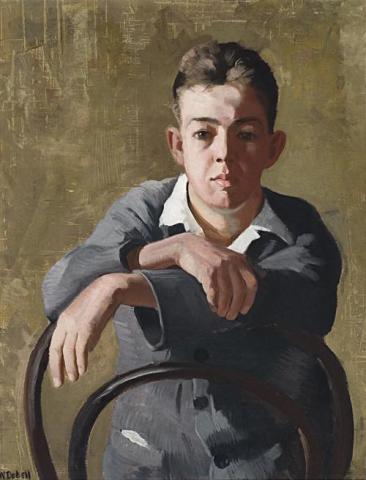THE BOY GEORGE, c.1928
William Dobell
oil on canvas
71.5 x 56.5 cm
signed lower left: W Dobell
inscribed verso: Dobell / The boy George
The Estate of Pro Hart, Broken Hill, New South Wales
Among Australia's great portrait painters, William Dobell is one of the finest. He produced some of the best portraits in the history of our art, and those of Dame Mary Gilmore and Margaret Olley are unforgettable. Others, such as The Billy Boy, although inspired by people he met, are superb character types, and not only confined to Australians - witness his acerbic Mrs South Kensington. Dobell was an artist of remarkable virtuosity using his considerable talents to produce portraits in which the character and occupation of the sitter are reinforced through the application of the medium and the brushwork. In The Strapper, for example, the paint is as caringly worked as would the strapper groom the horses in his charge. In Anthony Quayle as Falstaff, 1951, by contrast, the fullness of the personality flows through the rotund figure and generous strokes of the colour-laden brush. Many of the portraits reveal telling psychological insights into the sitter, as in his portrait of Joshua Smith, controversial winner of the 1943 Archibald Prize titled Portrait of an Artist.
The Boy George is an early portrait offering a rare insight into the beginnings and development of Dobell's gifts as a portrait painter. Its striking realism comes from the skill with which he creates the illusion of three-dimensional features on the flat canvas. Painted in the late 1920s while Dobell was attending the Julian Ashton's classes in the Sydney Art School, his training was essentially academic. The hero of the day was George Lambert from whom Dobell learnt the importance of underlying structure as distinct from the surfaces that beguile the eye. Working by day as a draughtsman at Wunderlich Ltd. in Redfern, the model for The Boy George was most likely from his everyday working world. The direct gaze of the model is met by the equally enquiring eye of the artist, and the painting reveals his mastery of draughtsmanship and the wonderful tactile quality of his paint, notable throughout his painting life. These talents were soon to be recognised in the award of the 1929 Society of Artists' Travelling Scholarship, and in London in 1930, a first prize for figure painting with Slade Nude, gifted in 1961 by the artist to his hometown Newcastle Region Art Gallery. Early paintings by Dobell are rare, with most held in public collections.
DAVID THOMAS
